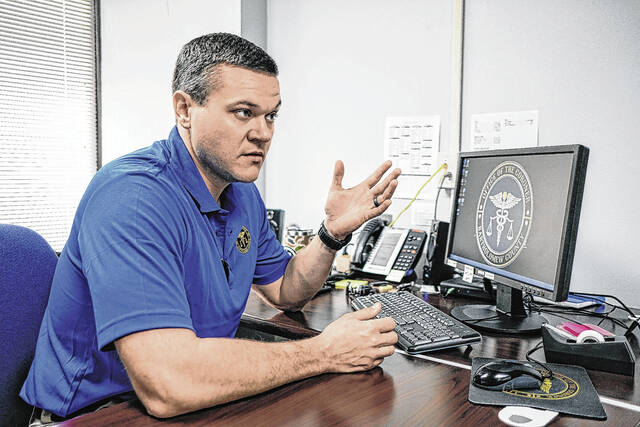
Mike Wolanin | The Republic Bartholomew County Coroner Clayton Nolting is shown during an interview at his office in Columbus, Ind., Wednesday, May 1, 2019.
Bartholomew County officials are expressing concern as drug overdose deaths this year have largely kept pace with last year, when the county recorded the highest number of fatal overdoses since at least 2015.
From Jan. 1 to this past Wednesday, there were 28 drug overdose deaths in Bartholomew County, according to the Bartholomew County Coroner’s Office. By comparison, the coroner’s office recorded 30 fatal drug overdoses from Jan. 1 to Oct. 30, 2020.
Overall, there were 31 drug overdose deaths in Bartholomew County in 2020, up from 24 in 2019 and the highest since at least 2015, according to a report from the coroner’s office.
“We’ve slowed down just a little bit (compared to last year),” said Bartholomew County Coroner Clayton Nolting.
“Obviously, one (death) is too many,” Nolting said.
National cases increase
The update from county officials came as the federal government reported that U.S. drug overdose deaths reached a record high over the latest 12-month period on record, eclipsing an estimated 100,000 deaths for the first time.
On Wednesday, the Centers for Disease Control and Prevention estimated that 100,300 Americans died of drug overdoses from May 2020 to April 2021 — including an estimated 2,487 in Indiana.
However, the figures are not an official count, The Associated Press reported. It can take many months for death investigations involving drug fatalities to become final, so the CDC made the estimate based on 98,000 reports it has received so far from the latest available death certificate data.
Overdose deaths have been rising across the country for more than two decades before accelerating during the past two years and jumping nearly 30% in the latest year — now surpassing deaths from car crashes, guns and even flu and pneumonia, according to wire reports. The total is close to that for diabetes, the nation’s No. 7 cause of death.
In Indiana, overdose deaths increased 1,875 from May 2019 to April 2020 to an estimated 2,487 during the same period this year, which would be an all-time high, CDC records show.
Drug overdose deaths have doubled in Indiana since the same time period in 2016, when 1,285 deaths were reported. A total of 148 people died from a drug overdose in Bartholomew County from Jan. 1, 2015 to this past Wednesday, according to coroner’s office records.
Fentanyl concerns
Experts believe the top drivers of overdose deaths are the growing prevalence of deadly fentanyl in the illicit drug supply and the COVID-19 pandemic, which left many drug users socially isolated and unable to get treatment or other support, according to wire reports.
The new data shows many of the deaths involve fentanyl, which has surpassed heroin as the type of drug involved in the most overdose deaths five years ago. Dealers are mixing fentanyl with other drugs.
Fentanyl is a synthetic opioid that is 50 to 100 times more potent than morphine and is often illegally produced and sold on the streets for its heroin-like effect, according to the Centers for Disease Control and Prevention.
Locally, most drug overdoses deaths so far this year involved multiple drugs, though fentanyl and methamphetamine remain among the most common substances turning up in toxicology reports, Nolting said.
There were a total of 133 emergency room visits in Bartholomew County due to a drug overdose during the first half of this year, with about 52% of the visits involving an opioid, according to the most recent data from the Indiana Department of Health.
By comparison, there were 144 emergency room visits in Bartholomew County during the first half of last year and 122 during the same period in 2019.
“If it has got an opiate involved in it, then it’s generally fentanyl,” Nothing said of the overdose deaths that his office investigates. “And if it’s a stimulant, then it’s generally methamphetamine.”
Seeking help
For its part, the Alliance for Substance Abuse Progress (ASAP) has continued to see a steady stream of people seeking help coming into its Hub at the Doug Otto Center at 1531 13th St.
ASAP Director of Operations Matthew Neville said the organization has seen what much of the rest of country has seen since rolling back pandemic-related restrictions. “The combination of COVID and fentanyl have just absolutely ravaged the population that we’re here to serve,” Neville said.
Additionally, ASAP has distributed over 560 doses of Naloxone, a medication designed to rapidly reverse an opioid overdose, since May at two public dispensers located near the United Way offices and the Bartholomew County Public Library, Neville said.
ASAP hopes to install two or three more locations for the dispensers in Columbus in the near future.
Launched in 2017, ASAP is a community-wide response to address substance use disorder, including the opioid crisis, in Bartholomew County. ASAP was formed through a partnership between Columbus and Bartholomew County governments and Columbus Regional Health.
The CDC, for its part, previously reported there were about 93,000 overdose deaths in 2020, the highest number recorded in a calendar year, according to wire reports. Robert Anderson, the CDC’s chief of mortality statistics, told the AP that the 2021 tally is likely to surpass 100,000.
The newly released data found the estimated death toll rose in all but four states — Delaware, New Hampshire, New Jersey and South Dakota — compared with the same period a year earlier, according to wire reports.
The states with largest increases were Vermont (70%), West Virginia (62%) and Kentucky (55%). Indiana saw a 32% increase.
“The overdose numbers are obviously a concern,” Neville said. “The CDC, when they released the data, talked about the toll that fentanyl is playing in terms of creating more overdoses and raising the overdose deaths and (we’re) just trying to make people aware that fentanyl is extremely dangerous.”
“It’s extremely potent,” Neville added. “That’s obviously going to be a great concern moving forward.”
The Associated Press contributed to this report




